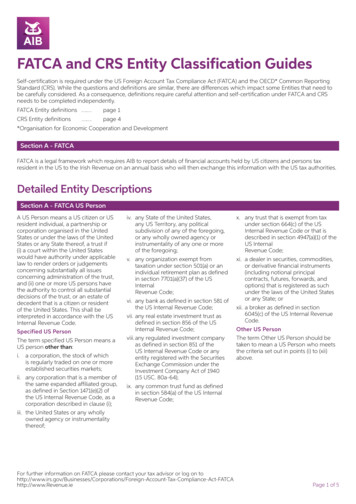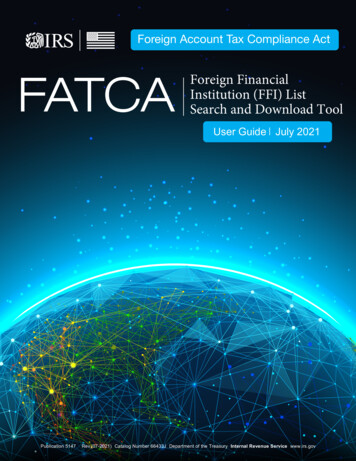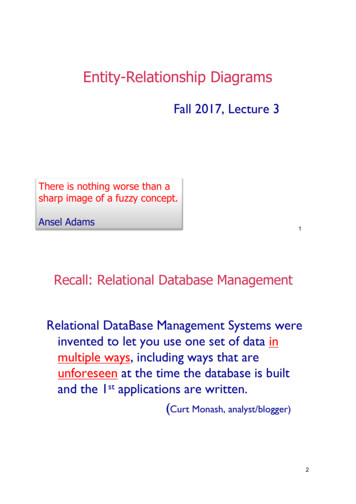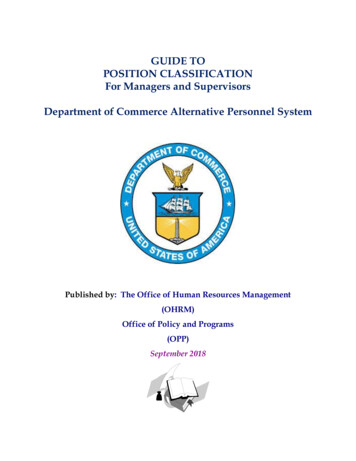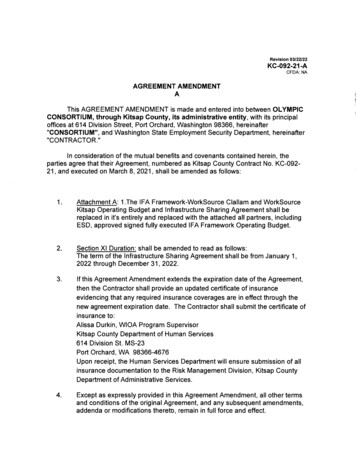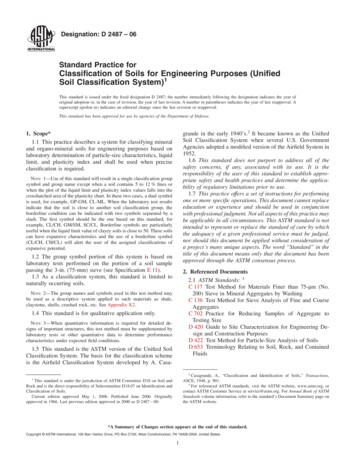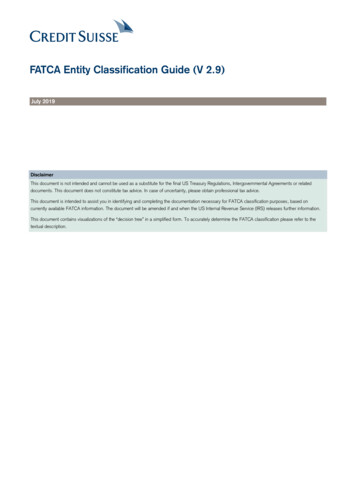
Transcription
FATCA Entity Classification Guide (V 2.9)July 2019DisclaimerThis document is not intended and cannot be used as a substitute for the final US Treasury Regulations, Intergovernmental Agreements or relateddocuments. This document does not constitute tax advice. In case of uncertainty, please obtain professional tax advice.This document is intended to assist you in identifying and completing the documentation necessary for FATCA classification purposes, based oncurrently available FATCA information. The document will be amended if and when the US Internal Revenue Service (IRS) releases further information.This document contains visualizations of the “decision tree” in a simplified form. To accurately determine the FATCA classification please refer to thetextual description.
ContentsGeneral Information . 3Purpose of these guidelines . 3Section 1 . 4Beneficial Owner or Intermediary . 4Beneficial Owner . 4Intermediary . 4Section 2 . 6Recommendation for entities that may be financial institutions . 6Countries with FATCA Intergovernmental Agreements (IGAs) . 6Section 3 . 7Overview . 7Part 1 – Short Questionnaire . 7Part 2 – Non-financial Foreign Entity FATCA Classification Options . 7Part 3 – Foreign Financial Institution FATCA Classification Options . 7Part 1: Short Questionnaire to Determine FATCA (i.e., Chapter 4) Status . 8Part 2: Non-financial Foreign Entity (NFFE) Determination . 10Category 1: Non-financial foreign entities engaged in an active trade of business . 10Category 2: Publicly traded non-financial foreign entities and their affiliates. 12Category 3: Non-financial foreign entities organized in US Territories . 13Category 4: Governmental Entities, International Organizations and Central Banks of Issue . 13Category 5: Holding Companies and Treasury Centers . 14Category 6: Nonprofit Organizations . 16Category 7: Section 501(c) Entities . 16Category 8: Passive non-financial foreign entities . 18Part 3: FFI Information . 19General Information . 19Category 1: Retirement funds. 21Category 2: Trusts and closely held investment entities (i.e. entities with less than 20 individual investors) . 22Category 3: Deemed-Compliant FFIs . 27Glossary . 292FATCA Entity Classification Guide (V 2.9)
General InformationPurpose of these guidelinesAs a result of the Foreign Account Tax Compliance Act (FATCA), Credit Suisse’s (“our” or “we”) documentation requirementshave been necessarily updated and enhanced. The documentation we require from our clients (“you” or “your”) is now dependentupon several factors including: (i) your classification under FATCA and (ii) whether you are the beneficial owner of the account oracting as an intermediary on behalf of another person or entity. These guidelines are intended to assist you in identifying andcompleting the documentation necessary for FATCA classification purposes.Determining your classification for FATCA purposes can be a complicated and extensive process. In order to assist you, theseguidelines provide a sample approach to determining your FATCA account classification and are intended to be only a guide inmaking this determination. Additionally, these guidelines provide explanations and examples to assist you in understandingwhether you are the beneficial owner or an intermediary related to the account. Please note that it is possible, after consideringthe points herein, to conclude that more than one FATCA classification is possible. If this occurs, please obtain professional taxadvice.Note: Decision tree visualizations represent a simplified graphical form. To accurately determine the FATCA classification pleaserefer to the textual description.US EntitiesIf you are an entity organized or incorporated in the US (excluding the US territories), please ignore these guidelines and provide a Form W-9 to yourrelationship manager (and a waiver if you are dealing with a Bank located in a jurisdiction with legal restrictions regarding reporting).If you are not an entity organized or incorporated in the US, but you have already undertaken a FATCA classification review within your entity’sorganization and already know your FATCA classification, please provide a completed W-8BEN-E or Form W-8IMY or a “FATCA Self Certification Form”for Entities to your relationship manager.Do not use Form W-8BEN-E if you are a person acting as intermediary (please review section 1 below).yesIgnore guide, provideW-9, [waiver]Entityorganized/incorporatedin US?noFollow steps of guideFATCA Entity Classification Guide (V 2.9)3
Section 1The purpose of this section is to assist you in deciding whether you are the beneficial owner or an intermediary related to youraccount; which determines whether you will file a W-8BEN-E or W-8IMY or a “FATCA Self Certification Form” for Entities. Thedetermination of whether you are a beneficial owner or intermediary is a separate and distinct determination than that of yourFATCA status.If you already know which form to complete, you may skip this section and proceed to Section 2.If you are uncertain as to whether the entity is an intermediary or beneficial owner after considering the information below, pleaseconsult a professional tax advisor.Beneficial Owner or IntermediaryBeneficial OwnerA beneficial owner of an account is the person or entity that owns the assets and the income received in the account. This isgenerally the person or entity that would be required to pay tax on the income (i.e., the person who is the owner of the income fortax purposes and who beneficially owns that income).If you are the beneficial owner of the account, please download and complete a Form W-8BEN-E from the IRS website1, or aself-certification form available from the Credit Suisse FATCA Internet site.The Form W-8BEN-E or self-certification should be used by:Non-US entities that beneficially own the assets and/or the income being receivedUnless a corporate entity has elected otherwise, generally such corporate entities are treated as the beneficial owner of theincome/account. Some common corporate entities include but are not limited to: Swiss examples: Aktiengesellschaft (AG), Gesellschaft mit beschränkter Haftung (GmbH),Kommanditaktiengesellschaft Other examples:Germany: Aktiengesellschaft (AG)Luxembourg: Societe Anonyme (SA)Netherlands: Naamloze Vennootschap (NV), Besloten vennootschap (BV)United Kingdom: Public Limited Company (Plc)Mexico: Sociedad Anonima (SA)Brazil: Sociedade Anonima (SA)Hong Kong: Private Limited Company, Limited Liability CompanyJapan: Kaibushiki GaishaAustralia: PTY Limited For a more extensive list of entities that are considered corporations, please see the term “per se corporations” in theglossaryDo not use Form W-8BEN-E or a self-certification if you are an individual (US or non-US) or an entity organized or incorporatedin the US (excluding the US territories).If you are investing, or plan to invest, in US securities please use a Form W-8BEN-E only, and do not use a self-certificationform.IntermediaryAn intermediary is a person or entity that acts on the behalf of another person or entity, and an intermediary typically owns theassets and receives income on behalf of another person in their capacity as a nominee, custodian, broker, signatory, investmentadvisor or agent.If you are an intermediary, please download and complete a Form W-8IMY from the IRS website.The Form W-8IMY should be used by:14Please see guidance below for alternative documentation applicable as long as the entity is not investing into U.S. securities.FATCA Entity Classification Guide (V 2.9)
Non-US partnerships / flow-through entities (e.g., Kollektivgesellschaft, Kommanditgesellschaft, Einfache Gesellschaft (ifnot treated as joint account)Non-US simple trustsNon-US grantor trustsQualified IntermediariesNonqualified IntermediariesOther entities acting as intermediaries (e.g., law firms or fiduciary companies)FATCA Entity Classification Guide (V 2.9)5
Section 2Recommendation for entities that may be financial institutionsIf you are a financial institution and you have previously determined your FATCA classification, please complete either the FormW-8IMY or W-8BEN-E or a “FATCA Self Certification Form” for Entities, as applicable. There is no need for you to continuethrough the remainder of this document.If you believe that for purposes of FATCA you may be a financial institution based on the activities of your entity (see below) andyou have not previously conducted an assessment of FATCA’s impact on your business, please consult your professional taxadvisor for further guidance on what FATCA means for your entity.Typical activities that are commonly considered those of a financial institution include but are not limited to:Engaging in a banking businessProviding depository or custodial accounts to customersProviding trust or fiduciary servicesProviding advice, administration and/or management services related to client investments (e.g., in securities, partnershipinterests, etc.)Issuance of cash value insurance and/or annuity contractsCountries with FATCA Intergovernmental Agreements (IGAs)Considering your jurisdiction of tax residence, please follow the US Treasury FATCA link /treaties/Pages/FATCA.aspx) and take note of whether your country of tax residence is treated as having anIGA in effect with the US. If your country of tax residence is listed as having an IGA in effect, please take note of whether suchIGA is a Model 1 or Model 2 (note: Switzerland has signed a Model 2 IGA).This information will be necessary to understand your FATCA classification.Persons and entities with tax residence in countries without an IGA in effect should refer to the US Treasury Regulations todetermine their FATCA status.6FATCA Entity Classification Guide (V 2.9)
Section 3OverviewThis section is divided into 3 parts as follows:Part 1 – Short QuestionnaireThis part contains 11 questions that are focused on your business activities and in assisting you in determining whether you are afinancial or non-financial institution for FATCA purposes. The responses you give to these 11 questions will determine whetheryou continue to Part 2 or Part 3.Part 2 – Non-financial Foreign Entity FATCA Classification OptionsThis part contains 10 possible classification options for nonfinancial foreign entities. Each category contains 1 to 3 questions toassist you in determining whether each category is applicable for you.Part 3 – Foreign Financial Institution FATCA Classification OptionsThis part contains two initial questions and is followed by three categories that contain further questions or information aboutpossible high-level classification options for financial institutions. If you believe you are a financial institution, we encourage you toconsult a professional tax advisor for further guidance on what FATCA means for your entity.FATCA Entity Classification Guide (V 2.9)7
Part 1: Short Questionnaire to Determine FATCA (i.e., Chapter 4)StatusThe purpose of the following 11 questions is to assist you in determining whether you are a financial or non-financial institutionfor FATCA purposes. Your response to each question will determine whether you need to continue through all 11 questions orwhether you can skip ahead to either Part 2 or Part 3. Please start with question number 1 and follow the relevant references.US entities onlyIf you are an entity organized or incorporated in the US (excluding the US territories), please ignore these guidelines and complete Form W-9 and awaiver of secrecy where required.Questions 110 (financial)Yes to anyNo to allNon-Financial (active trade), e.g.? Manufacturing? Construction? Agriculture? Retail? Utilities? Health Services? Educational Services? Social ServicesyesNFFEGo to Part 2(non-financial)Question 11(non-financial)noFFIGo to Part 3(financial)Financial (see guide for details):1. Banking, credit or similar license2. Regulated by financial services oversightbody, e.g. FINMA, SEC,BaFin, etc.3. Holding shares in other companies (holdingcompany) and shares are of bank or similar4. Treasury center and affiliates which arebanks or similar5. Issue cash value insurance or annuitycontracts6. Offer accounts: Deposit, custodial, etc.7. Provide investment advice, managementservices, etc.8. Investment entity9. Retirement/pension funds10. Professionally Managed: Trust, foundation,domiciliary company, partnership, etc.Domiciliary CompaniesIf you are a domiciliary company we encourage you to consult a professional tax advisor, as the classification of domiciliary companies is particularlycomplex for FATCA purposes.8FATCA Entity Classification Guide (V 2.9)
1)Does the entity have a banking, credit or similar license?a) If yes, move to Part 3: FFI Information.b) If no, move to the next question.2)Is the entity regulated by any financial services oversight body? E.g., FINMA, SEC, BaFin, Financial Conduct Authority, etc.a) If yes, move to Part 3: FFI Information.b) If no, move to the next question.3)Does the entity primarily exist to hold shares in other companies? (i.e., is the entity a holding company?)a) If yes, does the entity hold shares in a bank, investment entity, or custodial entity?i) If yes, move to Part 3: FFI Information.ii) If no, move to the next question.b) If no, move to next question.4)Is the entity a treasury center?a) If yes, does the entity have affiliates that are banks, investment entities or custodial institutions?i) If yes, move to Part 3: FFI Information.ii) If no, move to the next questionb) If no, move to next question.5)Does the entity issue cash value insurance or annuity contracts?a) If yes, move to Part 3: FFI Information.b) If no, move to the next question.6)Does the entity offer any of the following types of accounts: deposit accounts, custodial accounts, checking accounts,savings accounts, etc.?a) If yes, move to Part 3: FFI Information.b) If no, move to the next question.7)Does the entity provide investment advice, administration services or management services to clients (e.g., as a domiciliarycompany or asset manager) for purposes of investing their funds (i.e., by buying or trading securities, partnerships interestsor establishing or managing trusts)?a) If yes, move to Part 3: FFI Information.b) If no, move to the next question.8)Does the entity primarily conduct business as or market itself as an investment entity or similar vehicle (i.e., the entityinvests, reinvests or trades in financial assets like securities, partnership interests, etc.)a) If yes, move to Part 3: FFI Information.b) If no, move to the next question.9)Is the entity a retirement or pension fund?a) If yes, move to Part 3: FFI Informationb) If no, move to the next question.10) Is the entity a fiduciary structure (e.g., Trust, Foundation, Domiciliary Company, Partnership or similar) and mainly invests inFinancial Assets?a) If yes, is the entity professionally managed (including having a Discretionary mandate with a Financial Institution orExternal Asset Manager, but specifically not those which are advisory only)?i) If yes, and do not meet one of the exemptions2 (see footnote 2 below), move to Part 3: FFI Information.ii) If no, you should consider both Part 2: NFFE Determination and Part 3: FFI Informationb) If no, move to the next question.11) Is the primary purpose of your entity’s business to conduct a non-financial business? E.g., manufacturing, construction,agriculture, retail, utilities, health services, educational services, social services, etc.a) If yes, move to Part 2: NFFE Determination.b) If no, move to Part 3: FFI Information.2Exemptions form the definition of Investment Entity are entities defined by FATCA regulations as either Excepted non Financial Group Entities,Excepted start up Entities, Excepted non Financial Entities in liquidation, 501(c) entity or Non-Profit OrganisationFATCA Entity Classification Guide (V 2.9)9
Part 2: Non-financial Foreign Entity (NFFE) DeterminationRegistration with IRSIf you are a non-financial foreign entity that has registered with the IRS as a Direct Reporting NFFE or as a Sponsored Direct Reporting NFFE, pleaseinform your relationship manager and provide the relevant GIIN on a completed W-8BEN-E or W-8IMY form, as applicable. There is no need for you tocontinue through the remainder of this document.Cat. 1: Q1-Q2Active TradeNo to allActive NFFE (aNFFE)Cat. 5: Q1-Q3Holding,TreasuryYes to anyCat. 2: Q1PubliclyTradedyesRegulations: Publicly tradedNFFE or affiliateIGA: aNFFECat. 6: Q1-Q2Charitable, taxexemptyesRegulations: Non ProfitOrganizationIGA: aNFFEyesRegulations: 501(c)organizationIGA: aNFFEnoyesRegulations: Exceptedterritory NFFEIGA: aNFFECat. 7: Q1Section 501(c)nonoCat. 4: Q1Governmentetc.Regulations: NonfinancialGroup EntityIGA: aNFFEnonoCat. 3: Q1US TerritoriesyesyesCat. 8Regulations: Govm't, Int'lOrg., Central BanksIGA: aNFFEPassive NFFE (pNFFE)noCategory 1: Non-financial foreign entities engaged in an active trade of business1)2)Is more than 50% of the entity’s gross income from passive income for its previous reporting period or calendar year?a) If yes, move to Category 2.b) If no, move to the next question.Do more than 50% of the assets held during the previous reporting period or calendar year produce passive income, or areotherwise held for the production of passive income?a) If yes, move to Category 2.b) If no, you may qualify as an Active NFFE. Please review the tables below to determine the relevant FATCAdocumentation. You are not required to proceed further in these guidelines. However, if you would like to evaluate theother classification options, please move to Category 2.Note: There might be further entity types meeting the active NFFE definition according to an applicable IGA (see Annex I,Section VI(B)(4) of the applicable IGA).Applicable regulations forcountry of residence of the entityaccount holderRelevant FATCA Status InstructionsSwitzerlandActive NFFENo documentation required for FATCA3 – Please informyour relationship manager that you are an Active NFFEIf the entity claiming this status is a Domiciliary Company (Sitzgesellschaft), contacted through a mailing process, or it isunclear to Credit Suisse that the Active NFFE is suitable, such entity must complete the form “Active NFFE Declaration” ora W-8BEN-E or W8-IMY or a “FATCA Self Certification Form”.310 FATCA Entity Classification Guide (V 2.9)
All other countriesActive NFFEPlease complete the form “Active NFFE Declaration”provided by Credit Suisse, or a W8-BEN-E or W8-IMY or a“FATCA Self Certification Form” for EntitiesFor those who have accounts in SwitzerlandFor those who have accounts outside of SwitzerlandApplicable regulations forcountry of residence of the entityaccount holderRelevant FATCA Status InstructionsAll countriesActive NFFEPlease complete the form “Active NFFE Declaration”provided by Credit Suisse, or a W8-BEN-E or W8-IMY or a“FATCA Self Certification Form” for EntitiesThe following examples are provided as a representative sample of the types of entities that may be engaged in an activebusiness and is in no way intended to be a comprehensive list of all entities that could be classified as an Active NFFE.Examples: Business that may qualify as Active NFFEsFarmsManufacturing CompaniesManagement Consulting CompaniesArchitect OfficesSports, religious, educational, charitable, scientific, or literary organizations, associations, or clubs (see Annex I, Section VI(B)(4) of the applicable IGA)Example: Foreign entity engaged in an active businessThe daily business of Bakery ABC consists of baking goods (cakes, pies, breads, etc.) and selling these products to customers. Bakery ABC has beenvery successful over the last five years and has been able to invest its profits into securities. Therefore, in addition to income received from the sale ofbaked goods, Bakery ABC also earns passive income (i.e., interest and dividends) on its investments. In the prior year, Bakery ABC earned grossincome of USD 2 million from the sale of baked goods and USD 70k of interest and dividends on its investments. On December 31 of the prior year,Bakery ABC had assets of USD 10 million of which USD 1 million is invested into securities and the remaining USD 9 million consists of equipment,inventory and other assets that are used in the daily production of the baked goods. Bakery ABC qualifies as an Active NFFE because more than 50%(2mil / 2.07mil 96.6%) of the gross income in the prior year is attributable to their active business of selling baked goods and more than 50% (9mil /10mil 90%) of the assets held by Bakery ABC are used in the production of such active income.FATCA Entity Classification Guide (V 2.9) 11
Category 2: Publicly traded non-financial foreign entities and their affiliates1)Is the stock of the corporate entity listed on and regularly traded on an established securities market for the previousreporting period or that calendar year?a) If yes, please review the tables below to determine the relevant FATCA documentation.b) If no, move to the next question.Note: This category only applies to non-financial entities. Publicly traded financial institutions should review the classificationoptions for financial institutions contained in Part 3.2)Is the entity an affiliate (i.e., related by ownership greater than 50%) of a corporation whose stock is listed on and regularlytraded on an established securities market for a previous reporting period or that calendar year?a) If yes, you may qualify as a publicly traded NFFE or affiliate. Please review the table below to determine the relevantFATCA documentation. You are not required to proceed further in these guidelines. However, if you would like toevaluate the other classification options, please move to Category 3.b) If no, move to Category 3.For those who have accounts in SwitzerlandApplicable regulations for theentity account holderRelevant FATCA Status (check box insection 5 of W-8BEN-E or W-8IMY)InstructionsFinal US Treasury RegulationsPublicly traded NFFE or NFFE affiliate ofa publicly traded corporationComplete Part XXIII on either Form W-8BEN-Eor W-8IMY (please also complete box 37a andprovide the name of a securities exchange onwhich the stock of your entity is publicly traded)or a “FATCA Self Certification Form” for EntitiesSwitzerlandActive NFFENo documentation required for FATCA –Please inform your relationship manager thatyou are an Active NFFE4All other Model 1 or 2 IGAcountriesActive NFFEPlease complete the form “Active NFFEDeclaration” provided by Credit Suisse, or a W8BEN-E or W8-IMY or a “FATCA SelfCertification Form” for EntitiesFor those who have accounts outside of SwitzerlandApplicable regulations for theentity account holderRelevant FATCA Status (check box insection 5 of W-8BEN-E or W-8IMY)InstructionsFinal US Treasury RegulationsPublicly traded NFFE or NFFE affiliate ofa publicly traded corporationComplete Part XXIII on either Form W-8BEN-Eor W-8IMY (please also complete box 37a andprovide the name of a securities exchange onwhich the stock of your entity is publicly traded)or a “FATCA Self Certification Form” for EntitiesAll other Model 1 or 2 IGAcountriesActive NFFEPlease complete the form “Active NFFEDeclaration” provided by Credit Suisse, or a W8BEN-E or W8-IMY or a “FATCA SelfCertification Form” for EntitiesIf the entity claiming this status is a Domiciliary Company (Sitzgesellschaft), contacted through a mailing process, or it isunclear to Credit Suisse that the Active NFFE is suitable, such entity must complete the form “Active NFFE Declaration” ora W8-BEN-E or W8-IMY or a “FATCA Self Certification Form”.412 FATCA Entity Classification Guide (V 2.9)
Examples: Established Securities MarketsThe New York Stock Exchange5, the Nasdaq Stock Market5, any Swiss stock exchange6, and the stock exchanges of Amsterdam, Frankfurt, London,Milan, Paris, Tokyo and Vienna.Category 3: Non-financial foreign entities organized in US Territories1)Is the entity organized in a US territory and are all of the owners of the entity residents of that US territory?a) If yes, you may qualify as an NFFE organized in a US Territory. Please review the table below to determine the relevantFATCA documentation. You are not required to proceed further in these guidelines. However, if you would like toevaluate the other classification options, please move to Category 4.b) If no, move to Category 4.Applicable regulations for theentity account holderRelevant FATCA Status (check box insection 5 of W-8BEN-E or W-8IMY)Final US Treasury RegulationsExcepted territory NFFEComplete Part XXIV on either Form W-8BEN-Eor W-8IMY or a “FATCA Self Certification Form”for EntitiesModel 1 or 2 IGAActive NFFEPlease complete the form “Active NFFEDeclaration” provided by Credit Suisse, or a W8BEN-E or W8-IMY or a “FATCA SelfCertification Form” for EntitiesInstructionsThe US territories include American Samoa, Guam, the Northern Mariana Islands, Puerto Rico or the US Virgin Islands.Category 4: Governmental Entities, International Organizations and Central Banks of Issue1)Is the entity* a foreign (i.e., non-US) government, a government of a US possession, an international organization, a foreign(i.e., non-US) central bank of issue, or an entity wholly owned by one or more of these?a) If yes, you may qualify as a Governmental Entity, International Organization, or Central Bank of Issue. Please review thetable below to determine the relevant FATCA documentation. You are not required to proceed further in theseguidelines. However, if you would like to evaluate the other classification options, please move to Category 5.b) If no, move to Category 5.As an exchange that is registered under section 6 of the Securities Exchange Act of 1934 with the Securities andExchange Commission s.shtml)6As an exchange listed under the Limitation of Benefits article 22 of the Swiss income tax TCA Entity Classification Guide (V 2.9) 13
Applicable regulations for theentity account holderRelevant FATCA Status (check box insection 5 of W-8BEN-E or W-8IMY)InstructionsFinal US Treasury RegulationsForeign government, a government of aUS possession, an internationalorganization, a foreign central bank ofissue, or an entity wholly owned by one ormore of theseIf the entity is a foreign central bank, completePart XIII on Form
consult a professional tax advisor. Beneficial Owner or Intermediary Beneficial Owner A beneficial owner of an account is the person or entity that owns the assets and the income received in the account. This is generally the person or entity that would be required to pay tax on the income (i.e., the person who is the owner of the income for

